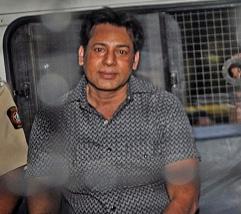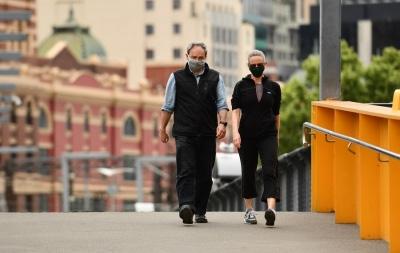
23 minute read
Yogi govt in UP to develop Naimish Dham as Vedic city
Lucknow, July 11: The Uttar Pradesh government is all set to develop Naimish Dham as a Vedic city and the global centre for spiritual and religious tourism. An action plan has already been prepared in this regard on the instructions of Chief Minister Yogi Adityanath to develop Naimisharanya pilgrimage site in four phases on the lines of Kashi, Ayodhya and Mathura. According to the government spokesman, the chief minister has also directed concerned authorities to start electric bus and helicopter services between Lucknow and Sitapur soon in order to facilitate travel to Naimish Dham for pilgrims from both within the country and abroad. Tourism, Urban Development, PWD and Irrigation departments will work together on the project. As per the action plan, the development of prominent projects such as Chakra pilgrimage site, Maa Lalita Devi Temple, Dadhichi Kund and Sita Kund will take place in the first phase while Dadhichi Kund, Rudravart Mahadev, Devdeshwar Temple and Kashi Kund would be developed in the second phase. Similarly, separate action plans have been chalked out for urban and regional development. The chief minister has also issued directives to authorities for ensuring availability of clean water in all the ponds of Naimisharanya, renovation of Chakra pilgrimage site and beautification of Dadhichi Kund and Maa Lalita Devi temple. The government has also decided to expand the area of Misrikh Municipality and develop Kosi Parikrama Path. Furthermore, Yogi Adityanath has instructed authorities to acquire land as per requirement to carry out tourism development and beautification works in Naimish Dham and make adequate arrangements for tourists’ accommodation, lighting, parking and security, reiterating the government’s commitment to develop the dham, which happens to be the shrine of 88,000 sages. Meanwhile, the Tourism, Urban Development, PWD and Irrigation departments have been directed to prepare a concrete action plan for tourism development in Naimish Dham. The Tourism Department will also prepare a convenient tourism package for Naimishdham. It may be mentioned here that Naimisharanya pilgrimage site is a centre of faith for crores of Sanatan Dharma followers. There are many places of mythological and spiritual significance at Naimish Dham such as Maa Lalita Devi Temple, Chakra, Vyas Gaddi, Soot Gaddi and Hanuman Garhi among others. Lakhs of devotees visit the pilgrimage site every full moon and new moon as well as on occasions such as Navratri and fourteen Kosi parikrama of the month of Phagun.
Over 7,100 pilgrims leave for Amarnath cave shrine from base camp
Advertisement

Srinagar, July 12 (IANS): Amarnath Yatra, which was resumed on Monday after a two-day suspension following flash flood near the cave shrine, continued on Tuesday as another batch of 7,107 pilgrims moved from Jammu base camp towards the Valley. Flash flood near the cave shrine on Friday killed 16 people and injured 37 while 15,000 were rescued. Reports that 40 pilgrims from Andhra Pradesh are missing have been denied by the Andhra Pradesh government saying that only two pilgrims from that state are still missing while all others are safe. Officials said Yatra was resumed on Monday from Pahalgam base camp while it was not resumed from Baltal base camp because the 14 km long north Kashmir trek is damaged at three places. “Helicopter services for the Yatris continued from both the base camps to the cave shrine,” officials said. Another batch of 7,107 pilgrims left Bhagwati Nagar base camp in Jammu in two escorted convoys for the Valley on Tuesday. “Of these, 5,158 are going to Pahalgam while 1949 are going to Baltal,” officials said. Over 1,20,000 pilgrims have so far had Darshan inside the holy cave shrine. The 43-day long Amarnath Yatra 2022 started on June 30 and will end on August 11 on Shravan Purnima coinciding with the Raksha Bandhan festival.
Killing of chicks gone up alarmingly: PETA

Lucknow, July 12: An investigation carried out by People for the Ethical Treatment of Animals (PETA) India has found that the gruesome and killing of chicks has gone up by thousands at a time. (PETA) India, at an emergency press conference held here shared the findings of its latest undercover investigation into numerous hatcheries across major egg- and/ or chicken meat-producing states-Andhra Pradesh, Maharashtra, Tamil Nadu, Telangana, and Uttar Pradesh. Hatcheries are where chicks are born before they are sent to farms. The footage shows day-old chicks being dumped into drums, pits, rubbish bins, and ponds and left to die; buried alive using earthmovers; drowned, crushed, suffocated, and burned alive; fed alive or ground up alive to be fed to fish; and abandoned to be eaten by dogs or eagles. Some are coloured with chemicals and sold to children, which means they are ultimately mishandled and commonly starved to death. Among the companies named in PETA India’s report are major industry players like Venky’s, Skylark Group, and Srinivasa Farms. “Newborn chicks are being drowned, burned alive, and killed in other violent and horrific ways at hatcheries across the country, all for the fleeting taste of meat or eggs,” said PETA India Senior Advocacy Officer Harshil Maheshwari. PETA India has called on people, rightfully appalled by these practices, to go vegan today, without any delay. Today, chickens used for meat are bred to have heavy, fleshy upper bodies, while those used for eggs are bred for abnormally high egg production. Male chicks are considered useless by egg hatcheries because they don’t lay eggs and, thus, they are usually killed. Meanwhile, in both the meat and egg industries, many chicks are rejected because of size or health issues and also killed. PETA India is urging the Indian government to follow in the steps of France and Germany by mandating that the Indian poultry sector adopt in ovo-sexing technology, which allows male embryos to be identified at an early stage of development so that an egg, rather than a live bird, can be destroyed. PETA India has also asked the sector to seek guidance from the Animal Welfare Board of India on the humane handling of chicks who are sick and weak. This investigation marks the second time that PETA India has revealed haphazard, atrocious chick-killing practices in the country. Previously, PETA India had publicised video footage taken by Animals Now (previously Anonymous for Animal Rights) of unwanted chicks in India being drowned, burned, ground up, crushed, and fed alive to fish by the lakhs in 2016. PETA India’s latest investigation proves that the poultry sector continues handling chicks in cruel ways and that a government policy on the matter is an urgent need.
Centre bound to release Abu Salem after 25 years imprisonment: SC
New Delhi, July 11 (IANS): The Supreme Court on Monday said the Central government is bound to honour the commitment given to the Portuguese government and release gangster Abu Salem on completion of 25 years imprisonment, following his conviction in the Mumbai serial blasts case. A bench of Justices Sanjay Kishan Kaul and M.M. Sundresh said: “On the appellant (Abu Salem) completing 25 years of sentence, the Central government is bound to advise the President of India for exercise of his powers under Article 72 of the Constitution, and to release the appellant in terms of the national commitment as well as the principle based on comity of courts.” The top court also made it clear that Abu Salem’s detention period will begin from October 2005, and not from September 2002 - when he was arrested pursuing Red Corner notice. Abu Salem was represented by advocate Rishi Malhotra in the top court. After the top court’s order, Abu Salem would be released from jail in 2030. The bench added: “The necessary papers be forwarded within a month of the period of completion of 25 years sentence of the appellant. In fact, the government can itself exercise this power in terms of Sections 432 and 433 of the CrPC. and such an exercise should also take place within the same time period of one month.” At the beginning of the verdict, Justice Kaul, who authored the judgment on behalf of the bench, said crime and punishment is something which has agitated the judicial minds and punishment cannot be disproportionately high or low. “It should not be oppressive, but should serve the purpose of deterrence against crimes in a society along with a sense of justice to the victim and their family. This is a delicate balance, which has to be kept in mind,” he said.
During the hearing, Abu Salem’s counsel contended that the assurance was given to the Portuguese government by India that he will not be either awarded death penalty or punished beyond 25 years, but he has been sentenced with life imprisonment by the court. The top court noted that the Indian government had given a solemn sovereign assurance on December 17, 2002, in view of the powers of the President of India under Article 72(1) of the Constitution. As the President acts on the aid and advice of the government under the provisions of Article 74 of the Constitution and, thus, the government is bound itself to advice the President to commute the sentence to 25 years in view of its commitment to the Courts in Portugal. The bench said it respects the very basis on which the courts of Portugal observed the principles of comity of courts by recognising that there is a separation of powers in India and, thus, the courts cannot give any assurance. “The corresponding principle of comity of courts, thus, has to be observed such that the Government of India having given the solemn assurance, and having accepted the same before us, is bound to act in terms of the aforesaid,” it said. It added that the judiciary had to perform its functions of imposing a sentence in accordance with law, while the executive would have to perform its duty by restricting the sentence in conformity with the assurance given to the Portuguese courts. The Central government, in an affidavit, had submitted that it is bound by the assurance dated December 17, 2002 and the period of 25 years which is mentioned in the assurance will be abided by it at an appropriate time subject to the remedies which may be available. However, at this, the top court had said: “We did not appreciate the underlined portion aforesaid as once it was recognised that the government would abide by the assurance, nothing more or less was to be said. As far as the courts were concerned, they were to take a view as to the effect of that assurance.” The bench emphasised that the courts must proceed in accordance with law and impose the sentence as the law of the land requires, while simultaneously the executive is bound to comply with its international obligations under the Extradition Act as also on the principle of comity of courts, which forms the basis of the extradition. A special TADA court in February 2015, sentenced Abu Salem to life imprisonment in another case of murdering Mumbai-based builder Pradeep Jain in 1995 along with his driver. The gangster was extradited from Portugal in November 2005.

Delhi Court defers Alt-News co-founder Mohammed Zubair’s bail hearing to July 14
New Delhi, July 12: A Delhi Court on Tuesday adjourned to July 14 the hearing on a bail plea filed by Alt News co-founder Mohammed Zubair in a case related to an “objectionable tweet” which allegedly promoted enmity between religious groups. Additional Sessions Judge Devender Kumar Jangala noted that the Supreme Court is hearing a separate case in this regard and accordingly, the matter was adjourned. During the course of the hearing, Zubair’s counsel Vrinda Grover reiterated the arguments, in which she questioned what is so provocative about the 2018 tweet even after four years and also said police is constantly adding improvements to the initial case. New charges invoked against Zubair are under Sections 120B (criminal conspiracy) and 201 (causing disappearance of evidence) of the Indian Penal Code (IPC) and Section 35 of the Foreign Contribution (Regulation) Act. Public Prosecutor Atul Shrivastava, the newly-appointed Special Public Prosecutor for Delhi Police, apprised the court that he is in Bhopal and sought time to reply as the apex court is also hearing the matter. On July 2, Chief Metropolitan Magistrate Snigdha Sarvaria at the Patiala House Courts rejected the bail plea of Zubair and granted his 14-day custody as sought by the Delhi Police. “Since the matter is at the initial stage of investigation and given the overall facts and circumstances of the case and nature and gravity of the offences alleged against the accused, no ground for grant of bail is made out,” Sarvaria said while dismissing Zubair’s bail plea. As per the FIR, accused Zubair had used a screengrab of an old Hindi movie which showed an image of a hotel, with its board reading ‘Hanuman hotel’ instead of ‘Honeymoon hotel’. In his tweet, Zubair had written, “BEFORE 2014: Honeymoon Hotel. After 2014: Hanuman Hotel.”The Delhi High Court had earlier issued a notice to the Delhi Police on a plea moved by Zubair challenging the Patiala House Courts’ order allowing his police custody and seizure of his laptop in connection with the alleged objectionable tweet.

Rain fury in Karnataka: Woman, daughter killed in wall collapse
Bengaluru, July 12 (IANS): A woman and her daughter were killed in a wall collapse incident in Markawada village of Uttara Kannada district as heavy rain continued to lash Karnataka on Tuesday. Several incidents of landslides, school building and house collapse were reported from coastal as well as north Karnataka region. The deceased are identified as 35-year-old Rukmini Vittal and her 13-year-old daughter Sridevi Vittal. The deceased were asleep when the incident took place. Though the neighbours tried to clear the debris, the victims had succumbed. Meanwhile, the authorities have fished out a youth’s body on Tuesday in Kaniyur near Puttur of Dakshina Kannada district. The search for another body is on. The deceased youth were travelling in a car which was washed away by flood water. The body was found 250 meters away from where the car was recovered. Following heavy rains, people living on banks of river Krishna in north Karnataka and Cauvery in south Karnataka have been asked to shift to dafer places. Chief Minister Basavaraj Bommai, before leaving for rain-affected regions in the state, took stock of the situation from Home Minister Araga Jnanendra, Minister for Revenue R. Ashok and Minister for Energy V. Sunil Kumar. After arriving in Mysuru, speaking to reporters Chief Minister Bommai stated: “We have inputs on loss of life, incidents of house collapse. The survey of loss to agriculture is being conducted.” “Importantly there is road connectivity loss due to heavy rains. There are landslides, Kodagu district has experienced earthquakes, and there is sea erosion. In north Karnataka, houses on river banks are damaged. First phase crop loss survey has been done in the state and I will get details in the evening,” he said. CM Bommai maintained that the National Disaster Management Authority has got Rs 739 crore funds to take up rescue and relief operations in the state. There is no dearth of funds for taking up relief work. There are sensitive seismic zones in Kodagu which experienced tremors recently. It has been happening in the same places. He further maintained that the entire government is engaged in addressing the woes of people in rain-affected regions. “I will issue directions for the district administration. I will stand with people,” he says.
Australia cuts Covid reinfection period to 28 days

Canberra, July 9 (IANS): The Covid-19 reinfection period or Australians has been advised to be reduced to 28 days, according to a statement from a medical expert committee. The Australian Health Protection Principal Committee (AHPPC), which is made up of federal, state and territory chief health officers, made the recommendation, reports Xinhua news agency. “Given reinfections may occur as early as 28 days after recovery from a previous COVID-19 infection, the AHPPC advises that the reinfection period be reduced from 12 weeks to 28 days,” it said. That means people who test positive for Covid more than 28 days after ending isolation due to previous infection should be reported and
managed as new cases. It warned that Australia was at the beginning of a new wave of infections driven by the BA.4 and BA.5 Omicron sub-variants. “This winter, we are experiencing significant community transmission of both COVID-19 and influenza, which is placing real stress on our community and health system,” the AHPPC said. “We expect that this wave will lead to a substantial increase in infections, hospitalizations and sadly, deaths, at a time when our communities and health systems are already under strain.” On Saturday, Australia reported more than 35,000 new Covid cases and over 70 deaths. The country’s overall caseload and death toll now stood at 8,413,831 and 10,225, respectively. There were 3,977 cases being treated in hospitals, including 141 in intensive care units.
Test skipper Cummins urges people to donate to crisis-hit Sri Lanka

Colombo, July 9 (IANS): Australia Test captain Pat Cummins on Saturday urged the world to donate wholeheartedly to Sri Lanka, which is in the midst of a massive economic crisis. The pace-bowling stalwart posted a video on social media and listed the hardships being faced by the island’s people, many of whom are not able to get two square meals a day. Cummins, Unicef’s Australia ambassador who is in Sri Lanka playing a two-Test series, tweeted, “Sri Lanka is facing its worst humanitarian crisis in decades. I recently sat down with Kowsala and Sathuja (two local girls) in Sri Lanka to speak about their experience and learn more about what’s happening on the ground.” “I have to say it’s an incredible country with fantastic people. However, day to day life here in Sri Lanka is tough at the moment and children are at the very heart of it,” said Cummins in a two-minute video on Saturday. “I recently spoke to Kowsala and Sathuja who live here in Sri Lanka and are a part of Unicef’s Sport for Development Programme.” The two girls narrated the hardships being faced by children in the country, with many forced to skip school due to the fuel shortage. “Due to the current economic and fuel crisis, it’s been a challenge for us to go to the ground to engage fully with cricket. Because of the fuel crisis, transportation is a problem now. It’s very difficult for use to get the bus,” said Kowsala, the captain of her school’s women’s cricket team. “The teachers are travelling from far and away but due to the fuel crisis, they aren’t coming to school regularly. Because of this, we have been struggling to learn. School is only open three days a week now,” she said, adding, “Most people are only having one meal a day. Most of the people who rely on fishing aren’t able to go fishing due to the fuel crisis. It’s very difficult,” she added. Cummins said he was part of Unicef’s programme which aims to provide “life-saving water, nutrition, health, education and child protection services”, adding that through the video, he wants to send out a message to people to “respond to the rising needs of children” by donating freely.
New Zealand PM in Australia to boost trade ties

Sydney, July 7: New Zealand Prime Minister Jacinda Ardern on Thursday attended the AustraliaNew Zealand Leadership Forum (ANZLF) in Sydney to boost trade ties between the two countries. “Building on our trans-Tasman trade and economic links is fundamental to ensuring New Zealanders’ economic security both now, and into the future,” Xinhua news agency quoted Ardern as saying in a statement. Topics discussed on the form include reconnecting through travel and tourism; trans-Tasman innovation opportunities; labour shortages and the future of work, economic growth challenges post-Covid-19; and climate change collaboration. Australia is New Zealand’s second-largest trading partner after China, with two-way trade accounting for over $13.6 billion in the year to December 2021, statistics show. Usually held around every 18 months, the forum last took place in 2019 in Auckland before Covid-19. Separate to the ANZLF, Ardern and Australian Prime Minister Anthony Albanese will hold their first formal Australia New Zealand Leaders Meeting on Friday in Sydney. Sydney, July 4 (IANS): Floods triggered by heavy rainfall across Australia’s southeast coast since last week has once again inundated Sydney and large parts of New South Wales (NSW) state, triggering the evacuation of thousands of residents. NSW Premier Dominic Perrottet addressed the public on Monday, urging residents in affected areas to follow emergency instructions, reports Xinhua news agency. “I want to continue to ask people to follow the instructions of the State Emergency Service (SES). If there is an evacuation warning in place, please get ready to evacuate. If there is an evacuation order in place, please leave immediately.” He said the NSW SES have received 1,593 requests for assistance overnight to Monday morning, and during the same time SES workers have performed 83 flood rescues. Across the state and in Sydney, there are currently 70 evacuation orders in place affecting over 32,000 people. Seven emergency evacuation centres have been established in the worst affected areas of the state. Rain and storm conditions are forecast to continue before easing on Tuesday. The Bureau of Meteorology (BoM) said parts of the state would receive an additional 50 to 100 mm of rainfall, which could prompt further flash flooding. The sudden flooding is in part due to the overflow of the state’s major dams which have been at 100 per cent capacity due to Australia’s historically wet summer. Emergency Management Minister Murray Watt said the unprecedented and unrelenting floods were a “very serious situation” and were further evidence to the lived reality of climate change in Australia. “The process from here is that the NSW government needs to formally declare a disaster. We are expecting that will happen pretty soon and that will trigger a whole range of federal and state government support,” Watt told national broadcaster ABC News on Monday morning.

NSW state commits to ‘historic’ handover of parkland to indigenous owners
Canberra, July 4 (IANS): The government of the Australian state of New South Wales (NSW) has commenced a programme that would see management of national parkland gradually transferred to the indigenous population. The joint management model would see the handback of national parkland, which covers nearly 1 per cent of NSW’s total area, over a 15-to-20-year period, reports Xinhua news agency. NSW Environment Minister James Griffin said that 30 per cent of the state’s national parks is already under Aboriginal joint management but Aboriginal people only hold title to just over 4 per cent of national parkland. “Expansion of the joint management model in this way would be a historic step that no other Australian jurisdiction and few other countries, if any, have taken,” said Griffin. The programme would also provide job opportunities for Aboriginal people and new business opportunities. About 3.2 per cent of Australia’s population, 812,000 people, were identified as being of Aboriginal and, or Torres Strait Islander origin in the country’s most recent census data released at the beginning of the month. Indigenous Australians experience lower levels of employment, shorter life expectancies, and reduced access to education compared to their non-indigenous counterparts. Aboriginal Affairs Minister of NSW Ben Franklin said the state government would be seeking input from Aboriginal people on how to make joint management arrangements work best for them while also giving them pathways to employment. “Developing a new model for joint management is one way to make meaningful progress on improving outcomes for Aboriginal people and communities in New South Wales,” said Franklin. While giving Aboriginal Australians new opportunities to engage with the land, the programme would also bring new knowledge into the conservation of bushland in the state. “This is about reconnecting people to country, aligning with native title processes and integrating Aboriginal knowledge in caring for country in the way they’ve been doing for tens of thousands of years,” added Franklin.

NZ, Aus PMs reaffirm renewed trans-Tasman relationship
Sydney, July 8 (IANS): New Zealand Prime Minister Jacinda Ardern and her Australian counterpart Anthony Albanese met in Sydney on Friday for their first annual Australia New Zealand Leaders Meeting. The meeting aimed to “further cement the close renewed relationship between Australia and New Zealand”, Xinhua news agency quoted Ardern as saying in a statement. The Prime Ministers discussed cooperation and engagement in the Pacific region, climate change and the responsibility of countries to commit to ambitious climate change action among others. Ahead of the meeting, Albanese said in a tweet that he and Ardern would discuss “opportunities for our countries to grow and improve living standards”. “We live in the most dynamic region in the world. The possibilities are boundless,” he added. The two leaders met informally in Australia in June shortly after Albanese won the election.

Melbourne announces plan to reduce Covid transmission at workplaces

Melbourne, July 8 (IANS):
Authorities in Melbourne on Friday released a project promising to cut down the transmission of Covid-19 by improving ventilation in office spaces throughout the city. A first-of-its-kind study evaluated three different ventilation systems over three months in vacant office buildings including displacement ventilation air conditioning, in-ceiling air filters, and natural airflow through open windows, reports Xinhua news agency. The pilot study found that while all three methods reduced the potential for transmission of airborne viruses, displacement ventilation air conditioning, which supplies air from the floor level, was the most effective in lowering Covid-19 transmission by 83 per cent, while also reducing energy consumption by 20 per cent. “This industry-leading research has identified simple but effective changes that can be implemented in office buildings to help workers feel safe, comfortable and protected,” said Melbourne Acting Lord Mayor Nicholas Reece. “Bringing people back to the city safely remains a key priority for the city of Melbourne, and that’s why we have undertaken this pilot study.” The project found that while opening windows reduced transmission by 53 per cent, it was not an ideal solution as it increased energy use by up to 20 per cent and was not available to all buildings. While data shows workers are beginning to return to the office in the wake of strict lockdowns, the return has been a trickle and not the flood many had predicted. Data from the Australian property representative body, the Property Council of Australia, has shown that in May office occupancy rates in Australian cities were still around 50 per cent of pre-pandemic levels. Beyond addressing workers’ fears about catching Covid-19 in the office, municipal governments have been rolling out various programs to incentivize workers to return to the office, including discounts for meals and free events for people during their lunch breaks. Similarly, businesses have been offering various hybrid work options to allow residents to maintain some of the flexibility of working from home while easing back into office life.








